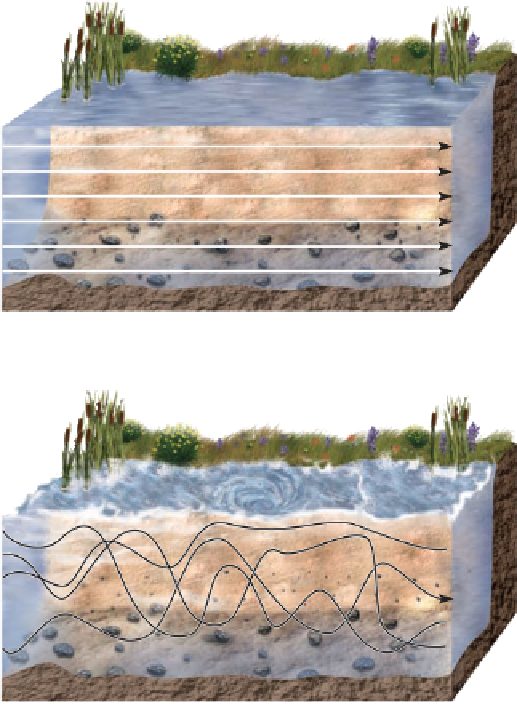Geology Reference
In-Depth Information
they depend more on infrequent rainstorms and surface
runoff for their water.
◗
Figure 12.4
Laminar and Turbulent Flows
Water in any channel flows downhill over a slope known
as its
gradient.
Suppose a river has its headwaters (source)
1000 m above sea level and it flows 500 km to the sea,
so it drops vertically 1000 m over a horizontal distance
of 500 km. Its gradient is found by dividing the vertical
drop by the horizontal distance, which in this example is
1000 m/500 km = 2 m/km (
Water surface
Figure 12.5a). On average,
this river drops vertically 2 m for every kilometer along
its course.
In this example, we calculated the average gradient for
a hypothetical river, but gradients vary not only among
channels but even along the course of a single channel.
Rivers and streams are steeper in their upper reaches (near
their headwaters) where they may have gradients of several
tens of meters per kilometer, but they have gradients of
only a few centimeters per kilometer where they discharge
into the sea.
The
velocity
of running water is a measure of the down-
stream distance water travels in a given time. It is usually
expressed in meters per second (m/sec) or feet per second
(ft/sec), and it varies across a channel's width as well as along
its length. Water moves more slowly and with greater tur-
bulence near a channel's bed and banks because friction is
greater there than it is some distance from these boundar-
ies (Figure 12.5b). Channel shape and roughness also infl u-
ence fl ow velocity. Broad, shallow channels and narrow, deep
channels have proportionately more water in contact with
their perimeters than channels with semicircular cross sec-
tions (Figure 12.5c). So, if other variables are the same, wa-
ter fl ows faster in a semicircular channel because there is less
frictional resistance. As one would expect, rough channels,
such as those strewn with boulders, offer more frictional
resistance to flow than do channels with a bed and banks
composed of sand or mud.
Intuitively, you might think that the gradient is the
most important control on velocity—the steeper the gra-
dient, the greater the velocity. In fact, a channel's average
velocity actually increases downstream even though its
gradient decreases! Keep in mind that we are talking about
average velocity for a long segment of a channel, not ve-
locity at a single point. Three factors account for this
downstream increase in velocity. First, velocity increases
even with decreasing gradient in response to the accelera-
tion of gravity. Second, the upstream reaches of channels
tend to be boulder-strewn, broad, and shallow, so fric-
tional resistance to flow is high, whereas downstream seg-
ments of the same channels are more semicircular and
have banks composed of finer materials. And finally, the
number of smaller tributaries joining a larger channel in-
creases downstream. Thus, the total volume of water (dis-
charge) increases, and increasing discharge results in
greater velocity.
◗
a
In laminar fl ow, streamlines are parallel and little mixing takes
place in the fl uid.
Water surface
b
In turbulent fl ow, streamlines intertwine, indicating mixing in
the fl uid.
not confi ned to depressions, and it accounts for
sheet ero-
sion
, a particular problem on some agricultural lands (see
Chapter 6).
In
channel fl ow
, surface runoff is confi ned to trough-
like depressions that vary in size from tiny rills with a
trickling stream of water to the Amazon River in South
America, which is 6450 km long and at one place 2.4 km
wide and 90 m deep. We describe flow in channels with
terms such as
rill
,
brook
,
creek
,
stream
, and
river
, most of
which are distinguished by size and volume. Here we use
the terms
stream
and
river
more or less interchangeably,
although the latter usually refers to a larger body of run-
ning water.
Streams and rivers receive water from several sources,
including sheet flow and rain that falls directly into their
channels. Far more important, though, is the water sup-
plied by soil moisture and groundwater, both of which fl ow
downslope and discharge into waterways. In areas where
groundwater is plentiful, streams and rivers maintain a
fairly stable fl ow year-round because their water supply is
continuous. In contrast, the amount of water in streams and
rivers of arid and semiarid regions fl uctuates widely because








Search WWH ::

Custom Search